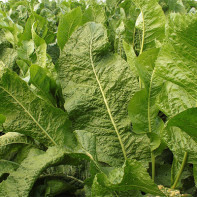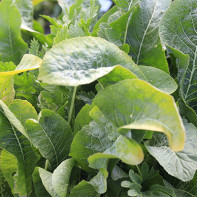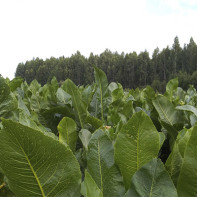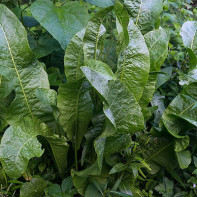Horseradish Leaves: Therapeutic Properties and Contraindications
Horseradish can safely be called a Russian traditional plant. Its history goes back several thousand years. It is popular in our time as well. Spices prepared from the poisonous plant belong to the national Russian cuisine. Horseradish is used not only in cooking, but also in other areas due to its valuable composition. And it is not difficult to grow it, since the vegetable is unpretentious and quickly grows on the homestead plot.
- Chemical composition
- How it looks and where it grows
- Habitats
- Varieties and species
- Planting and care
- Horseradish Harvest and Storage
- How to distinguish horseradish from horse sorrel
- Useful properties of horseradish leaves
- For Women
- For Men
- For weight loss
- Cooking Usage
- Horseradish Leaves in Folk Medicine
- Compress
- Bathing with leaves
- In osteoporosis
- In neuralgia
- In varicose veins
- In mastopathy
- Lumbar pains
- Kinds of medicinal compositions
- Infusion
- Infusion
- Decoction
- Tea
- Salve
- Cosmetic applications
- For fading skin
- For cellulite
- For hair growth
- For removing split ends
- For Dry Hair
- Can I Give Horseradish Leaves to Rabbits and Hens
- Contraindications for use
In this article we will talk about the benefits of horseradish, in particular its leaves, we will learn in what diseases it can help, how it is used in folk medicine, what can be prepared from the plant, how it affects the duration of storage of other products.
Let's start the story about the unique vegetable perennial with the chemical composition.
Chemical composition
Not for nothing this culture is called a natural antibiotic. This is explained by the high content of phytoncides in horseradish. These are substances that successfully fight germs and various infections. They are classified as synthetic antibiotics.

One of the main advantages of the plant - it is not necessary to look for it in stores. It is enough to plant in the country house or collect on the road. Horseradish can be found almost everywhere: near houses, in neglected areas, in meadows, in yards, along the banks of ponds, in willow, etc. But if you want to grow it yourself, nothing is easier. It has root propagation, it is not fastidious to the conditions of cultivation and care, which speaks of its energetic power.
As early as the 17th century, healers tried to cure cancer with it. In the treatment books of the 18th century, the plant was given special importance and used as:
- diuretic;
- anthelmintic;
- anti-inflammatory;
- blood-regulating, blood-regenerating and blood-purifying;
- an antiscinogen.
This is all due to the fact that the crop contains many beneficial substances for the human body. It is worth noting that horseradish is a low-calorie product, but tends to increase the appetite. In it (per 100 g) is present:
- kcal - 59;
- protein - 1,18;
- fiber - 3.3;
- carbohydrates - 11.29;
- fats - 0,69.
If we talk about macro- and micro-nutrients, vitamins, minerals, the plant contains:
- pyrodoxine;
- folate;
- pantothenic acid;
- niacin;
- thiamine;
- riboflavin, etc.
Vitamins of the group: A, PP, C, etc. It is worth noting that horseradish is several times ahead of lemon in terms of ascorbic acid content.
Elements:
- copper;
- sodium;
- iron;
- phosphorus;
- potassium;
- zinc;
- magnesium;
- calcium;
- lutein;
- Carotene, etc.
Horseradish has a special flavor due to the mustard and essential oils it contains. The juice contains a lot of lysozyme that can resist harmful infections and viruses. It improves the appetite and promotes the secretion of juice in the stomach, as does allyl oil.
The root, like the leaves, is rich in vitamin C. They do not lose their medicinal properties, and the vitamins are stored in the product for up to six months. But if the peeled roots are crushed, the loss of the vitamin will be inevitable. Grated horseradish contains only the remains of ascorbic acid. Therefore, in order to preserve the value of the product, you must immediately add acetic acid. This will not only preserve the vitamin C, but also give the seasoning special flavor properties. There is a lot of carotene in the leaves of the plant!
It is safe to say that at first glance inconspicuous vegetable - a treasure trove of mineral, biologically active elements and vitamins.
What does it look like and where does it grow?
Horseradish refers to perennials. It is a common crop belonging to the cabbage family. It has a thickened and fleshy root, which plays a special role in folk medicine. From the rhizome depart small lateral roots, which in their medicinal qualities are not inferior to the root itself, and even surpass it.

Distinctive features of the plant:
- The stem can be up to a meter or more in length. It is straight and fairly branched.
- The leaves have different shapes and sizes. At the bottom they are larger, reaching a diameter of 40 cm, in shape - pinnate-separate with a wavy edge. At the top, the leaves have an oblong shape, they are much smaller in size.
- The flowers are collected in a small bunch of white flowers at the top of the plant. Flowering begins in late spring to May and ends in mid-summer to June. The plant may not always bloom, remaining with only root leaves.
- The fruits are small in size.
Habitat
The usual habitats for this crop are moist areas, such as floodplains and river banks, meadows, brushwood, etc. It is not uncommon to find horseradish along land plots where it lives as a weed. It grows both in the middle belt of our country, and in the territory of Siberia.
It is worth noting that this wild plant first appeared in Europe. It is the European southwestern part is considered the birthplace of horseradish. The Germans began to cultivate the perennial back in the Middle Ages.
Varieties and species
Horseradish has several varieties and species. In Russia, a distinction is made:
- Meadow species.
- Common.
The first grows in Siberia, the second - in the central part of the Russian Federation. When deciding to grow a useful crop on your plot, you need to choose varieties appropriate to the climate.
Important! Variety seeds designed for growing in the middle belt will not take root in the territory of Siberia. It is also necessary to pay attention to the characteristics of the selected variety: when to plant, when to harvest, etc.
Of the varieties it is worth highlighting:
- Rostov;
- Suzdal.
These are the varieties that are grown by local vegetable growers. Of the bred are especially appreciated:
- Marune;
- Atlant;
- Wild or Valkovsky.
The culture should not be grown in the same place more than 3 years, otherwise the rhizome will harden and it can not be eaten. It is enough to keep it in the same bed for 2 years, so that horseradish will always be useful both as food and as a medicine.
Important! The perennial needs proper care, so that the plant does not become feral and begin to grow anywhere. This can lead to clogging of the land and crowding out of other crops.
Planting and care
The place for planting horseradish is better to choose a darkened place. The time of planting can be different - both in the fall and in early spring.
Interesting fact! It is important to plant the root in the position in which it grew earlier. In order not to get confused, it is necessary to make small "hints" for yourself when harvesting: having dug up the rhizome, make different cuts on it from the bottom and the top. For example, make an even cut at the top, and a beveled cut on the other side.
When planting, you need to keep a distance of at least 40 cm between the plants themselves and 70 between the rows. You should not deepen the root, he will be enough on top of 5 cm of soil. Place it in the ground at an inclination of about 45 degrees.
The culture does not require special care. It is enough to water it, so that the soil is not very dry, to carry out timely weeding and loosening. It is possible to add a little organic matter to the soil in the fall. When the root takes root, gives sprouts, it is desirable to fertilize the soil. Potassium-nitrogen fertilizer is ideal for this purpose. It is possible to fertilize the soil during the growth of horseradish, but you can do quite well without it. As we have already said, the plant is unpretentious and does not require special care.
Harvesting and storage
Harvest, as it should be, in the fall, in the middle or end of October. You can also harvest in early spring. The tastiest root crops are two or three years old. Gathering begins with the cutting of the leaves. Then dig up the ground with a pitchfork and manually pull the horseradish out of it. It may be necessary to dig deep, since some rhizomes are able to go far underground. Then it is necessary to sort into large, medium and small specimens. Flat and large fruits will be suitable for storage. The small ones can be replanted in the spring.
For harvesting, the rhizomes are cleaned of earth and dirt, cut off small growths and wormy parts. It is better to discard dead fruits at once. It is important not to damage the upper part of the rhizome if you plan to store it. Long-sized fruits are cut into pieces of 25-30 cm, then tied in bundles and placed in special, preferably wooden, boxes or trays. The top is covered with damp peat, you can use wet sand. Perfectly preserved fleshy thick rhizomes, whose diameter is 6 cm or more. Horseradish can be stored together with carrots. Store it in a cellar or other dark and damp place. If there is no such possibility, you should sprinkle the sand from time to time to keep the humidity at around 80 percent. It is important to keep the temperature in the room. It should not be below zero, but not more than +2°C.
The easiest way to store it is drying. To do this, the leaves and rhizomes are washed and dried outdoors, in the fresh air. Then they are sliced and sent to the oven to complete the process. The oven door is left open so that the fruit and leaves do not burn. You can use ordinary batteries, where to spread the pieces of vegetable culture on paper. If the horseradish plates will not break, you can finish drying them using the oven.
The finished product can be ground and used as an exclusive condiment to any dishes. Store in a cool, darkened place.
For the city dweller, the place of storage can be a balcony or a refrigerator. To do this, simply wash the vegetable, dry it, then wrap it in clingfilm and send it to the cold. For long-term storage the freezer will do.
Worth knowing! Dried or grated horseradish with proper preparation and observance of storage conditions will retain its value. You can make a sauce out of it right away, which will also be healthy and delicious!
How to distinguish horseradish from horse sorrel
Horse sorrel, like horseradish, is an herbaceous plant. You can tell them apart by their appearance.
- Leaves. Sorrel has oblong leaves, not wide like horseradish, and they are long.
- Flowers. The inflorescences of the sorrel are unsightly, greenish-yellow in color, collected in cylindrical forms. Horseradish has white, bright flowers.
Useful properties of horseradish leaves
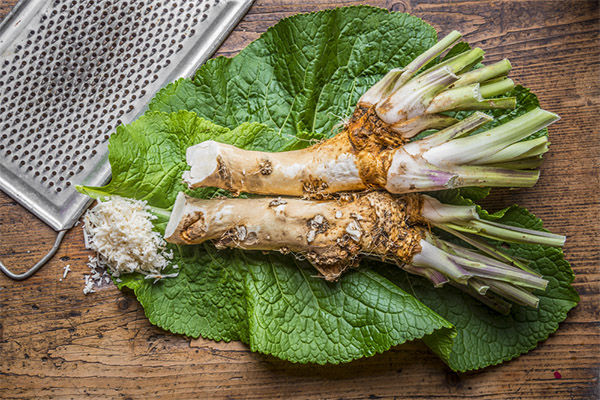
To begin with, let's note the energy value of the leaves per 100 g of the product:
- calories are few - 64 kcal:
- the leaf is rich in protein - 9,4;
- there are fats - 1,4;
- There are carbohydrates - 6.28.
The leaves contain water, ash and dietary fiber.
Let's list the main properties of horseradish leaves for humans:
- It helps to cope with illness more quickly. Saturates the body with valuable elements, fights viruses and infections.
- Activates and normalizes the digestive system. Increases the desire to eat, i.e. appetite. It is worth noting that, despite this, the plant will be useful for those who watch their figure. It takes a lot of energy to process horseradish. It turns out that the energy reserves obtained from the perennial will be spent on its digestion.
- It tones the heart muscle, lowers blood pressure, helps with atherosclerosis and other heart diseases.
- It is not called a natural antibiotic for nothing. It is. Horseradish is able to destroy harmful germs in the human body and prevent their further spread.
- Relieves inflammatory symptoms both inside and outside.
- Cleanses the body of toxins.
- Prevents the formation of salt deposits, helps in the regeneration of cartilage and tendons.
- Relieves headaches, calms the nervous system, an indispensable tool for insomnia. It is enough to put a leaf to the temple, hold it for a while and taste its flavor.
- Horseradish is useful for the respiratory tract. For example, alcohol infusion is used for maxillary sinusitis, and decoction treats cough and sore throat.
- It helps with problems with the urinary system and other similar diseases. It is considered a diuretic.
We have listed only part of the positive points that prove the usefulness of the culture for human health.
Important! By preparing drinks from horseradish in winter or in the spring, when the body especially needs to replenish the vitamin and mineral complex, you can avoid colds or infections.
For women
Horseradish is useful for women in almost everything, and most importantly, it normalizes the work of the digestive system. As you know, a woman always wants to be in shape and look good. Masks with horseradish can get rid of pigmentation on the face, eliminate freckles.
Recall that the product is low-calorie, but very useful. Therefore, it can be added to salads, any second courses, soups, etc.
During pregnancy and lactation you have to cut horseradish out of your diet!
For Men
It has been proven that horseradish can help with problems with male strength. For this purpose, it is better to take a tincture - the most common form of the healing agent. But the prepared "potion" should be made from fresh products. Dried ones will not do here.
Simple recipes for preparing a medicinal composition from horseradish:
- We take 0.5 kg of fresh rhizome, grind it in a combine or meat grinder. Put the ground parts in a jar, preferably a glass jar, and pour boiling water over it. You will need about 1.5 liters. Cover with lid, shake the contents of the container and insist 7 days in a dark place. At the end of the time take out the liquid, add honey at the rate of 0.5 kg, shake all the contents again and insist another week. It is not necessary to strain the prepared potion. It is better to drink one tablespoon before a meal. It is enough to take "medicine" 2-3 times a day. The infusion should be shaken regularly, so that the settled particles also participate in the process.
- Take 1 liter of vodka and a cup each of grated horseradish, freshly squeezed carrot juice, beet juice and honey. All stirred or shaken. Put in a dark place to infuse for 14 days. Take the same as in the previous recipe: a spoon before meals. This tincture is contraindicated for persons with GI problems.
Another important argument for the inclusion of horseradish in the diet of men is the ability of perennial to protect the heart and normalize the work of the heart muscle.
For weight loss
Horseradish is able to help with weight loss. It has a sufficient amount of fiber, thanks to which the feeling of hunger will disappear. But, the most important argument in favor of perennial is its low caloric content!
Thanks to the use of the plant as a food normalizes digestion, which is important for people who often conduct unloading days or those who prefer to diet.
Culinary Uses
Not only the leaves, but also the root of horseradish is used in culinary dishes. Usually the leaves go for pickling or marinating various vegetables, if they are in fresh form. They are also added to salads, soups, sauces, etc. Dried herbs are used as a condiment.

The plant is excellent in harmony with vegetables, meat, fish, etc. Its bitter and spicy flavor will give the soup a twist. For those who like their food "hotter", you can mix crushed leaves of perennial with mustard, garlic and pepper.
A traditional seasoning cannot do without the root, which gives the dish a tangy and spicy flavor. Each country has its own recipe, which is kept in the strictest secrecy. If we talk about the Russian cuisine, they do not add vinegar to the seasoning, but in Lithuania, on the contrary, they give preference to the vinegar base.
In our country, horseradish is mostly used as a seasoning. But there are fans of salads with the addition of chopped greens and the root of the plant. Grated horseradish root mixed with apples, carrots and beets makes an excellent snack. Usually it is dressed with vinegar, add sugar and salt at your discretion.
For a diet diet fit salad of grated in equal parts horseradish roots and celery. This snack is dressed with vegetable or olive oil.
Tasty turns out horseradish with sour cream. You need to grate the root of the vegetable, add sour cream, sugar to taste and salt as desired.
Recipe for making lightly salted cucumbers
- Wash the cucumbers and put them in a small container at the bottom. Fill the vegetables with water and leave for at least 2 hours. It is very important to let them soak in the water and make them crispy after salting.
- Prepare the spices. Peel the garlic and cut the cloves in half. Hot pepper (red) and horseradish root washed, cleaned and cut into arbitrary pieces of medium size.
- Take out a bowl, on the bottom of which we lay washed greens: dill, parsley, etc. Put chopped garlic, horseradish and pepper in the same place.
- On top of a dense layer of cucumbers, close to each other. Put new greens on top of the vegetables.
- Repeat the process as long as there is room in the bowl. The last layer should consist of greens.
- Prepare the brine. For this we pour 1 l of water into a saucepan, pour 2 tablespoons of salt in it. Watch yourself by the crock in which you put the cucumbers. If there are several layers of vegetables and the container is quite roomy, then it is clear that a lot more liquid will be needed. To prepare more brine, consider the ratio of salt to water. It is important that the prepared brine completely covers all the ingredients. The salt should dissolve in the water. If the solution is cold, then thoroughly stir the brine, so that no salt granules remain at the bottom.
- Pour the vegetables and cover them with horseradish leaves. The brine can be used both hot and cold. It all depends on your tastes and preferences.
- Salting vegetables for 3 days. But it is possible to take a sample after one day. Perhaps the cucumbers are salted properly, and they are ready to eat.
- We put the vegetables on a plate and serve them to our guests.
Horseradish leaves in folk medicine
Folk healers often use the leaves and roots of horseradish in their practice. From them prepare infusions, decoctions, use in fresh form.
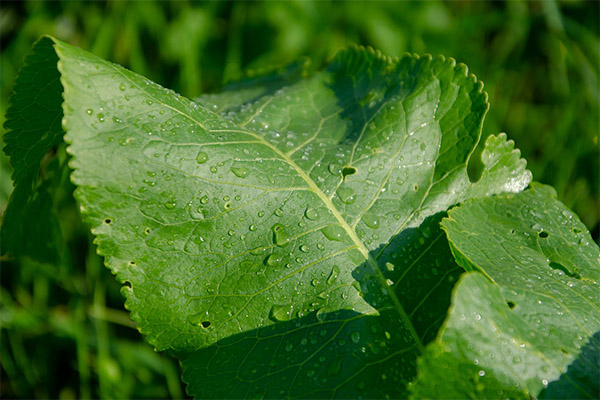
Let us tell you some of the secrets.
Compress .
It is made both from a whole leaf, and from crushed. For example, to get rid of salt deposits, you need to expose a leaf to boiling water and let it cool. Then put it on the problem area, wrap it with a warm towel or any cloth and keep it that way overnight.
Scalded leaves can be applied to aching joints to relieve pain and improve the condition.
Bathing with the leaves
Take no more than 15 leaves of the plant, pour 10-12 liters of hot water and insist a day, precover the container with a lid.
In the bath prepared pour 2-3 liters of infusion. Soak in the bath for 30 minutes. It is not recommended before the procedure to eat an hour before and after. Water should not be very hot. Such procedures help patients with osteochondrosis.
Osteoporosis
In such a disease, you should smear the painful areas with a tincture of young leaves in vodka.
With neuralgia
Only fresh horseradish leaves are used. To begin with, they should be washed and slightly dried. You can apply the wet leaves to the problem areas, soaking for at least 15 minutes.
In case of varicose veins.
A great way to get rid of the manifestations of varicose veins. To do this, you need to remove the stem from the leaves, so that they become pliable. Wash the leaves beforehand and let them dry. Apply the herbs alternately overlapping, making a sheet dressing, on the areas with varicose manifestations. Put a gauze bandage on top and wear knee socks or long socks. You can use an elastic bandage, but it should not be wrapped tightly. Leave the compress for the night in this condition.
With mastopathy
Tinctures of the rhizome, not the leaves, are used to treat this disease.
For lumbar pain.
It will help to get rid of intolerable pain in the lower back with a tincture on vodka from the leaves of horseradish. For such a solution, you need to collect young leaves in the spring - in May. To get rid of pain, you should rub the leaves on the lower back at night.
Types of medicinal compositions
Infusion
Pour boiling water over washed and dried leaves of horseradish at the rate of 5 leaves - 3 liters of water. Cover with the lid and leave to infuse in the refrigerator for 24 hours. Take half an hour before dinner, breakfast and lunch.
Tincture
Grind washed in advance and dried horseradish leaves. Put the resulting pulp in a glass container. Pour it all with vodka. Close the jar and insist for a week in the refrigerator.
At the end of the time, take out the tincture, strain it and start taking the course. You should drink 1 tablespoon before a meal, about 30 minutes. To improve the taste of the tincture and increase the effectiveness of the treatment, you can squeeze there the juice of a fresh lemon or add a little honey.
Decoction
The word decoction speaks for itself. You have to boil the leaves of horseradish. First wash all the leaves, dry and finely chop them. Pour steeped boiling water. For 25 g of leaves you will need 550-600 ml of water. Put the pot on fire and bring back to a boil. Remove from the heat and cool to room temperature. Use the decoction as follows: soak it in gauze and apply to the sick part of the body. It helps with pain in the knees caused by arthritis.
Tea
To make tea, you need to pour boiling water over the leaves and add sugar to them. It is better to use honey instead of sugar. The juice of a fresh lemon will improve the taste.
Ointment .
To prepare the ointment, you will need a blender, but you can use a food processor or meat grinder to grind. Grind horseradish leaves with an apple. Take equal proportions. Mix everything and immediately apply it to the problem areas.
An excellent ointment is obtained from the leaves of horseradish, turnip and radish mixed in equal parts. Such an ointment to treat painful areas up to 3 times a day.
Cosmetic use
Horseradish leaves are equally useful for both skin and hair. Below are a few recipes for masks, which are very easy to prepare at home and rejuvenate the face, as well as restore the former shine of the hair.
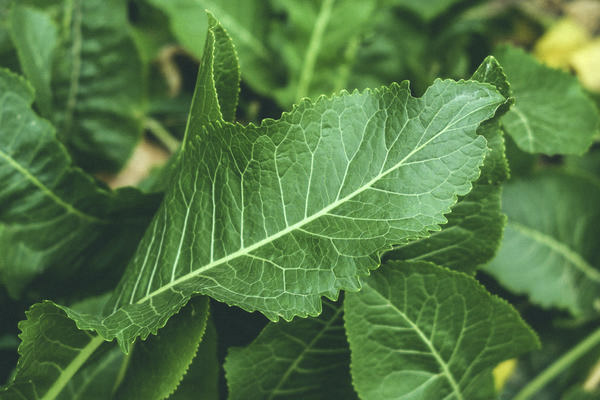
For fading skin
Thanks to this mask, your face will become tighter, fine wrinkles and the first signs of aging will disappear.
You need to crush in a separate bowl the leaves of the following plants:
- horseradish;
- plantain;
- yarrow.
Take all in equal proportions! Mix them and pour boiling water over. Let the solution infuse and wait at least 10 minutes. Then drain the water, leaving only the mush of herbs.
Apply it on your face, before cleansing yourself from makeup. Time of action of the mask - 20 minutes. Rinse off with cool water and apply moisturizing or emollient cream. The mask tightens the skin, refreshes and rejuvenates.
For cellulite
Grind horseradish leaves to a pulp, add to them the same part of the cream. The cream must be fat, not less than 20%. Stir everything and pour in oat flakes. The amount of flakes is equal to two parts. Bring the mixture to homogeneity and apply it with circular massaging movements to the problem areas. Wrap the body with cling film and keep for at least 20 minutes. Then rinse it off with a little warm water and apply cream. It is better to use creams based on citrus essential oils, then the effect of the procedure will be immediately visible.
Such wraps can be done 3 or 4 times a week, but not every day. Alternate procedures every other day. To completely get rid of the problem you need to do at least 10 wraps. To increase the effectiveness, you can apply the prepared composition to steamed areas of the skin after peeling.
For hair growth
Prepare 3 leaves of horseradish, 40 grams of fat sour cream and 15 drops of essential oil. For this mask you will need a pinch of dried nettles.
First turn the horseradish leaves into mush, i.e. crush them, add sour cream and oil and mix everything well. Apply a homogeneous mass on the hair, wrap with cling film and keep for 40 minutes. Wash off with the prepared nettle infusion. You need warm water and dry nettles at the rate of 2 cups of liquid - 1 tablespoon of dry herbs.
Regular performance of such procedures will accelerate growth and saturate the hair with moisture.
To get rid of split ends
Needed for the preparation of the mask:
- horseradish leaves - 8 leaves;
- egg - 3 pcs;
- Essential oil - 4 drops.
The oil can be any oil. To start, crush the leaves, add to them whipped eggs and oil. Stir and apply to the problematic ends. You can distribute throughout the hair to prevent sections. Cover the hair with cling film and a warm towel. Wait at least an hour and rinse with warm water. To achieve greater efficiency, you need to apply a special cosmetic oil on the ends.
For dry hair
You need to take:
- horseradish leaves - 5 pcs;
- sandalwood oil - 10-12 drops;
- Brewer's yeast - 25 grams;
- Black tea without additives.
Wash the leaves, dry them and grind them to a pulp. Add oil and yeast. Make tea (the amount will depend on the length and thickness of the hair) and dilute the mixture with it. Apply the resulting composition on the hair, cover with plastic wrap and wait for about 20 minutes. Rinse under running warm water.
This mask will not only moisturize the hair, but also return the previous shine.
Can we give rabbits and chickens horseradish leaves?
Giving leaves is not forbidden, and even useful. Horseradish has a sufficient number of useful elements that pets need to improve digestion. According to experienced farmers, the best option for feeding is to prepare mixtures of different herbs. Not all animals will accept single horseradish leaves with pleasure, as they will taste bitter.
Remember that pet food should be not only nutritious, but also healthy. This is the basis of good health, and therefore tasty meat and quality fur.
Contraindications to use
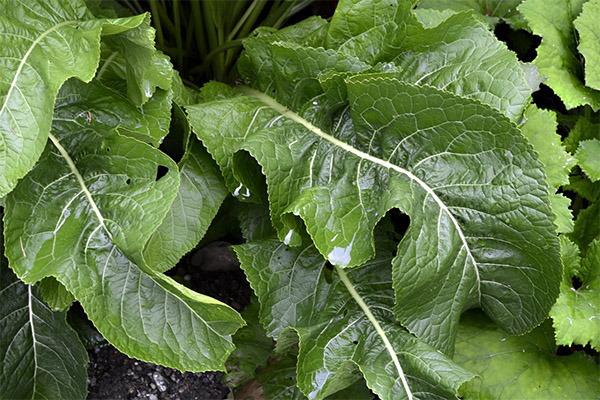
It is worth to be cautious about horseradish or exclude it from the diet altogether:
- pregnant women;
- breastfeeding mothers;
- Patients with stomach ulcers;
- Kidney problems;
- Inflammation of the digestive organs and system;
- Children under 5 years of age.
The plant should not be eaten in large quantities. You can eat it every day, but a little at a time. Abuse leads to irreversible consequences, such as stomach problems, high blood pressure, bleeding, etc.
«Important: All information on this site is provided for informational purposes only All information on this site is provided solely for educational purposes. Check with a health care professional before using any of our recommendations. specialist before using any of the recommendations. Neither the editors nor the authors shall be liable for any possible harm caused by materials."

